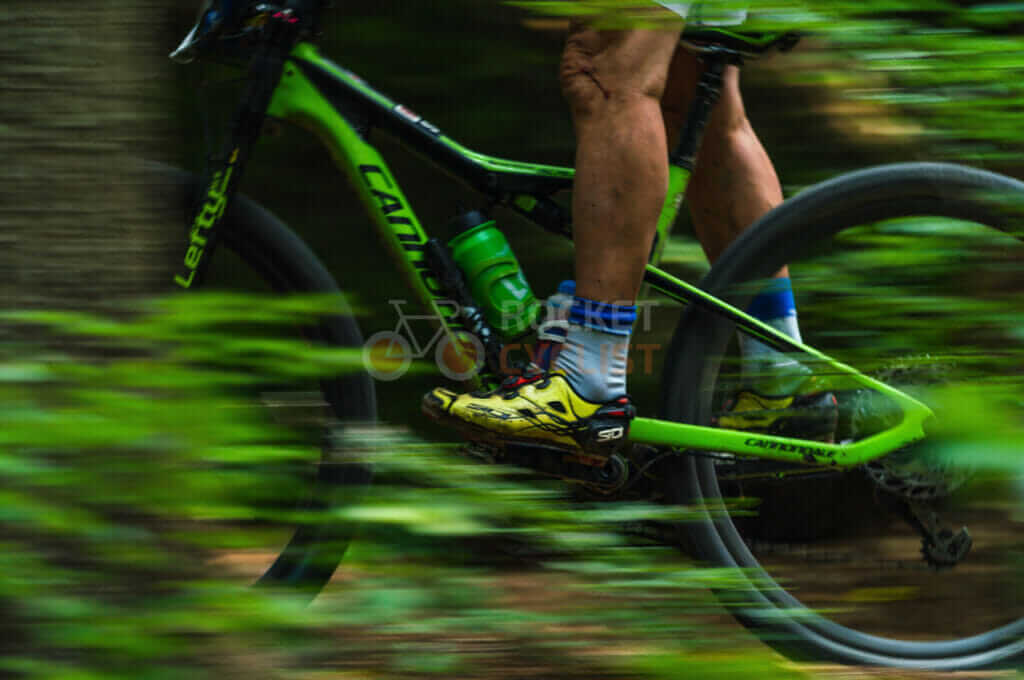Last Updated on July 2, 2023 by Vinson Lozano
Are you a cycling enthusiast looking for the perfect bike for your adventures? With so many options available, it can be difficult to choose between a gravel bike and a cross-country (XC) bike.
Both bikes are designed for off-road riding, but they have their differences. In this post, we’ll take a closer look at the advantages and disadvantages of both gravel bikes and XC bikes.
From tire size, handlebars, suspension, weight and geometry. We’ll break down the key differences to help you decide which bike is better suited for your riding style and needs.
So, whether you prefer long-distance rides on gravel paths or technical trails, read on to find out which bike is the best fit for you.

What gravel bikes and XC bikes are designed for?
Gravel bikes and cross country (XC) bikes are designed for different types of riding.
XC bikes are ideal for endurance and technical off-road mountain bike trails. These bikes are lightweight with minimal suspension, fast-rolling tires, and wider flat handlebars that provide more control and stability on challenging trails.
On the other hand, gravel bikes are designed to be ridden both on and off-road with drop handlebars that provide an aerodynamic position and a choice of hand positions that can provide improved comfort on long rides. The wider tires, lower gearing, and stable geometry make it easier to access and combine gravel paths, bridle paths, and smooth forest trails with ease.
Understanding the differences between these bikes is important when choosing the right one for your needs.
Gravel bikes typically do not have suspension forks, but recently released gravel bikes now have suspension. The reason is without suspension fork, it will help improve pedaling efficiency, and keep weight to a minimum.
XC bikes, on the other hand, typically have around 80-120mm of front suspension and some even have rear suspension to smooth out rough single-track trails.
Gravel bikes use lightweight 650b or 700c wheels, whereas XC bikes often use stronger 29-inch wheels. Gravel bikes tend to run tires around 40mm wide, which is much wider than most road bikes, allowing you to run much lower tire pressures, normally about 40psi.
XC mountain bike tires are even wider at around 55cm, allowing riders to run their tires between 24-30 psi, providing improved grip and better bump absorption on technical trails.
In conclusion, XC bikes and gravel bikes are designed for different types of terrain. If you plan to ride long distances on mixed trails or enjoy riding long distances on gravel paths, the gravel bike is a good option. If you prefer to handle technical trails and ride long distances, the XC bike might be your best bet. It all comes down to which type of riding you will be doing the most.
Main differences between the two types of bikes
Gravel bikes and cross country bikes may look similar, but they were designed for different types of terrains and riding styles. The main differences between these two types of bikes are explained below:
1. Purpose: Gravel bikes are designed for long distances on smooth off-road riding, whereas XC bikes are built for endurance and technical off-road mountain bike trails. This means that gravel bikes are lightweight with stable geometry and drop handlebars, while XC bikes are lightweight with minimal suspension and fast-rolling tires.
2. Handlebar: Gravel bikes have drop handlebars which provide a more aerodynamic position and a choice of hand positions that provide improved comfort on long rides. XC bikes have wider flat handlebars, which give much better control and stability on more challenging trails.
3. Suspension: Most gravel bikes do not have suspension forks, which helps improve pedaling efficiency and keep weight to a minimum. But then again, some of the recently released gravel bikes from various manufacturers comes with a suspension fork (air fork) like the Kespor X-Cross gravel bike which I am currently using on my gravel rides. XC bikes typically have around 80-120mm of front suspension.
4. Wheel size: Gravel bikes use lightweight 650b or 700c wheels, whereas XC bikes often use stronger 29-inch wheels. Gravel bike wheels are not designed for aggressive riding and will not stand up to rough XC or enduro trails.
5. Tire widths and pressures: Gravel bikes tend to run tires around 40mm wide, whereas XC mountain bike tires are even wider at around 55cm (2.2 inches). This allows the rider to run their tires between 24-30psi, giving them improved grip and better bump absorption. Gravel bikes use much lower tire pressures normally about 40psi.
6. Weight and efficiency: Gravel bikes are lighter, with an average weight of 10-11kg, whereas XC bikes have an average weight of 12-13kg. XC bikes are heavier because they have suspension and are built to handle rough terrain. Gravel bikes have slight rolling efficiency advantages.
7. Advantages and disadvantages: Gravel bikes are ideal for off-road touring, while XC bikes handle rougher terrain. Gravel bikes are perfect for riders who value comfort and want to cover long distances with ease. XC bikes are better for riders who value speed and agility.
In conclusion, the choice between a gravel bike and an cross country bike depends on the rider’s preferences and the type of terrain they will be riding on. Understanding the main differences between these two bikes can help riders make an informed decision and choose the bike that suits their needs best.
Comparison of the handlebars of gravel bikes and XC bikes
One of the main differences between gravel bikes and XC bikes is the handlebars they use.
Gravel bikes typically feature drop handlebars that are similar to those seen on road bikes. These handlebars allow for improved aerodynamics and a range of hand positions, making them ideal for long rides.
On the other hand, Cross country bikes usually feature wider flat handlebars, which provide more control and stability, making them better suited for technical and challenging trails.
It’s worth noting, however, that some gravel bikes have started incorporating wider flat handlebars too, making them a viable option for some off-road riding.
Ultimately, your choice of handlebars will depend on the type of riding you will be doing and your personal preferences. If you prefer to focus on long-distance rides on smoother terrain, drop handlebars may be the better option for you.
If you prefer more technical trails with challenging descents, wider flat handlebars may suit you better. It’s important to choose a bike that suits your needs and preferences to ensure the best possible riding experience.
Suspension differences between the two types of bikes

One of the main differences between gravel bikes and XC bikes is their suspension systems. While most gravel bikes are designed without a suspension system, most cross country bikes come equipped with front and rear suspension systems.
Here are some key differences to consider when comparing the suspension systems of these two bike types:
– Gravel bikes typically have a rigid front fork and no rear suspension. This means that they are less able to absorb impacts and vibrations on rough terrain, which can make for a bumpier ride.
– XC bikes, on the other hand, are built to handle more demanding terrain and come equipped with front and rear suspension systems. The suspension helps to absorb impacts and vibrations, which improves comfort and control.
– The suspension systems on XC bikes are typically designed to offer a range of adjustability, including options for adjusting settings such as compression and rebound damping. This allows riders to fine-tune the suspension to their specific needs and riding style.
– However, the added weight of a suspension system can make XC bikes slower and less efficient on flat terrain, compared to gravel bikes.
In summary, if you are planning to ride on rough terrain with lots of rocks, roots, and bumps, an XC bike with a suspension system might be the better choice.
However, if you’re staying on smoother terrain, a gravel bike with a rigid fork could be a more efficient and lightweight option. Ultimately, the best choice will depend on your riding preferences and goals.
Wheel sizes and types comparison
When comes to wheel sizes and types, gravel bikes and XC bikes have noticeable differences. Gravel bikes typically use lightweight 650b or 700c wheels, while XC bikes often use stronger 29-inch wheels.
While 700c and 29-inch wheels have the same diameter, 29-inch tires won’t fit 700c wheels as they are too wide for a 700c rim. Gravel bike wheels aren’t designed for aggressive riding and won’t stand up to rough XC or enduro trails. On the other hand, XC bike wheels are specifically designed to handle rugged terrain.
When it comes to tire widths, gravel bikes run tires around 40mm wide. This is much wider than most road bikes and allows riders to run much lower tire pressures (normally about 40psi). XC mountain bike tires are even wider, at around 55cm (2.2 inches), enabling riders to run their tires between 24-30psi.
With wider tires set to a lower pressure, XC bikes offer improved grip and better bump absorption, inspiring confidence on more technical trails. When it comes to efficiency, gravel bikes have a slight advantage in rolling efficiency. However, the difference is less than you would initially think.
Ultimately, the choice between a gravel bike and XC bike will depend on the terrain you’ll be riding the most. While gravel bikes are designed for long-distance smooth off-road riding, XC bikes are built to handle both technical trails and long distances. Understanding the differences between these two types of bikes can help you make an informed decision on which one best suits your individual needs.
Differences in tire widths and pressures
The widths and pressures play a crucial role in determining the performance of a bike.
Gravel bikes tend to run wider tires, approximately 40mm, which is much wider than most road bikes. On the other hand, XC mountain bikes run tires that are even wider, around 55cm or 2.2 inches.
The wider tire size on the XC bike allows for better grip and improved bump absorption, which can help to inspire confidence on more technical trails. Gravel bikes also tend to have a lower tire pressure, generally about 40psi, compared to XC bikes.
The lower tire pressure helps to improve grip and comfort, especially on long rides. In contrast, XC bikes have a higher tire pressure, averaging between 24-30psi, which can result in a more challenging and uncomfortable ride on long distances.
It’s important to keep in mind that the tire width and pressure should be chosen depending on the rider’s needs and preferred terrain. Both gravel bikes and XC bikes have different tire requirements and pressure specifications, so it’s essential to know what kind of riding you will be doing the most before choosing the type of bike best suited for your needs.
Also, running tire pressure that is too low or too high can negatively affect the tire’s durability and performance. Therefore, it’s essential to check the manufacturer’s recommended tire pressure and stick to it for optimal performance.
Weight and efficiency comparison
When comes to weight and efficiency, there are some key differences between gravel bikes and XC bikes. Let’s take a closer look at how these two types of bikes compare:
Gravel bikes tend to be lighter than XC bikes, with an average weight of around 10-11kg compared to 12-13kg for XC bikes. The main reason for this is that gravel bikes often do not have suspension forks, which helps reduce weight and improve pedalling efficiency.
However, XC bikes are designed to be more study and handle rougher terrain, which is why they often have more suspension and larger wheels. This added weight does come with a trade-off in terms of speed and efficiency, but it can be worth it if you’re tackling more technical trails.
Overall, the weight and efficiency of each type of bike will depend on the rider’s needs and preferred terrain. If you’re mainly riding long distances on mixed trails or gravel paths, a lightweight gravel bike may be a better choice for you. However, if you’re looking to tackle more technical trails or need a bike that can handle rougher terrain, a slightly heavier and more durable XC bike may be a better option.
Advantages and disadvantages of each type of bike

Gravel bikes and XC bikes both have their advantages and disadvantages depending on the rider’s needs and preferred terrain. Here are some pros and cons to consider:
Gravel Bikes Advantages:
– Can perform on any surface such as tarmac, mud, and everything in between.
– Taller head tube and slicker angle make for a relaxed steering experience.
– More stable and comfortable on all surfaces due to its longer frame.
– Can fit larger wheels and tires for improved grip and comfort on rough roads.
– Can easily switch to road tires for racing or commute.
– Designed simply with fewer components that can go wrong.
– Less expensive in the long run due to fewer maintenance costs.
Gravel Bikes Disadvantages:
– Slower compared to road bikes due to wider tires that create more resistance.
– Heavier than road bikes, which can be inconvenient for carrying up stairs or storing.
– More expensive than basic road or mountain bikes.
XC Bikes Advantages:
– Lighter and more efficient than gravel bikes.
– Suspension helps to absorb bumps and increase control.
– Designed specifically for off-road terrain and can handle rough trails better.
– Wider tire range for improved grip on different surfaces.
– Generally faster than gravel bikes due to narrower tires and lighter frame.
– More varied components available for customization.
XC Bikes Disadvantages:
– Less stable and comfortable on smoother surfaces due to shorter frame and suspension.
– More complex design with more components that can break or require maintenance.
– More expensive than basic road or gravel bikes.
In the end, the decision on which type of bike to choose depends on the rider’s individual needs and preferences. If versatility and simplicity are important factors, a gravel bike may be the best option. If speed and efficiency are the top priorities, an XC bike may be a better choice.
Recommendation on which type of bike to choose
In conclusion, both gravel bikes and XC bikes have their own advantages and disadvantages, and choosing the right one largely depends on the rider’s needs and preferred terrain. Here are some recommendations to help make an informed decision:
– If you enjoy riding on smooth gravel paths, forest trails, and mixed terrain, a gravel bike would be a good option. It is lightweight, features drop handlebars with multiple hand positions for improved comfort, and has wide tires that allow you to run lower tire pressures for better grip and bump absorption.
– If you enjoy technical off-road mountain biking and traversing rough terrain, an XC bike would be a better option. It has wider flat handlebars that provide better control and stability, and features suspension forks to smooth out rough single-track trails. It also uses stronger 29-inch wheels for better performance on more challenging trails.
It’s important to keep in mind that the weight and efficiency of both types of bikes vary. Gravel bikes tend to be lighter and more efficient, while XC bikes are slightly heavier due to their suspension and study built to handle rougher terrain. Additionally, the tire widths and pressures also differ between the two, with gravel bikes having wider tires and lower pressures than XC bikes.
Overall, it’s crucial to choose a bike that fits your needs and preferred terrain. Whether it’s a gravel bike or an XC bike, having the right bike will enhance your riding experience and make your trips more enjoyable.


